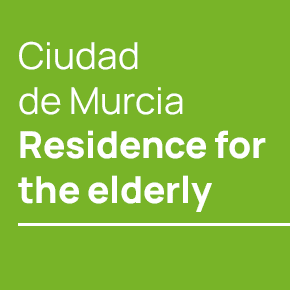- Region
- Águilas
- Alhama de Murcia
- Jumilla
- Lorca
- Los Alcázares
- Mazarrón
- San Javier
-
ALL AREAS & TOWNS
- AREAS
- SOUTH WEST
- MAR MENOR
- MURCIA CITY & CENTRAL
- NORTH & NORTH WEST
- TOWNS
- Abanilla
- Abarán
- Aguilas
- Alamillo
- Alcantarilla
- Aledo
- Alhama de Murcia
- Archena
- Balsicas
- Blanca
- Bolnuevo
- Bullas
- Cañadas del Romero
- Cabo de Palos
- Calasparra
- Camping Bolnuevo
- Campo De Ricote
- Camposol
- Canada De La Lena
- Caravaca de la Cruz
- Cartagena
- Cehegin
- Ceuti
- Cieza
- Condado de Alhama
- Corvera
- Costa Cálida
- Cuevas De Almanzora
- Cuevas de Reyllo
- El Carmoli
- El Mojon
- El Molino (Puerto Lumbreras)
- El Pareton / Cantareros
- El Raso
- El Valle Golf Resort
- Fortuna
- Fuente Alamo
- Hacienda del Alamo Golf Resort
- Hacienda Riquelme Golf Resort
- Isla Plana
- Islas Menores & Mar de Cristal
- Jumilla
- La Azohia
- La Charca
- La Manga Club
- La Manga del Mar Menor
- La Pinilla
- La Puebla
- La Torre
- La Torre Golf Resort
- La Unión
- Las Palas
- Las Ramblas
- Las Ramblas Golf
- Las Torres de Cotillas
- Leiva
- Librilla
- Lo Pagan
- Lo Santiago
- Lorca
- Lorquí
- Los Alcázares
- Los Balcones
- Los Belones
- Los Canovas
- Los Nietos
- Los Perez (Tallante)
- Los Urrutias
- Los Ventorrillos
- Mar De Cristal
- Mar Menor
- Mar Menor Golf Resort
- Mazarrón
- Mazarrón Country Club
- Molina de Segura
- Moratalla
- Mula
- Murcia City
- Murcia Property
- Pareton
- Peraleja Golf Resort
- Perin
- Pilar de la Horadada
- Pinar de Campoverde
- Pinoso
- Playa Honda
- Playa Honda / Playa Paraíso
- Pliego
- Portmán
- Pozo Estrecho
- Puerto de Mazarrón
- Puerto Lumbreras
- Puntas De Calnegre
- Region of Murcia
- Ricote
- Roda Golf Resort
- Roldan
- Roldan and Lo Ferro
- San Javier
- San Pedro del Pinatar
- Santiago de la Ribera
- Sierra Espuña
- Sucina
- Tallante
- Terrazas de la Torre Golf Resort
- Torre Pacheco
- Totana
- What's On Weekly Bulletin
- Yecla


- EDITIONS:
 Spanish News Today
Spanish News Today
 Alicante Today
Alicante Today
 Andalucia Today
Andalucia Today
Museo Hidráulico Los Molinos del Río Segura
Murcia watermill museum, the Molinos del Río
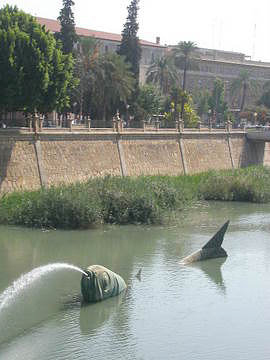 Located on the banks of the River Segura, which flows through the centre of Murcia, this is an atmospheric, working watermill museum, a vital cog in the food chain which supplied Murcia and thecapital in the days before food production became so heavily mechanised.
Located on the banks of the River Segura, which flows through the centre of Murcia, this is an atmospheric, working watermill museum, a vital cog in the food chain which supplied Murcia and thecapital in the days before food production became so heavily mechanised.
But it's more than just a museum, it's a centre for music, art, photography and education, hosting concerts in the intimate surroundings of the museum itself ,and with art galleries in not only the interior of the old mill, but also in the stable buildings in which farmers could leave their horses when flour and peppers were brought in from the countryside for milling.
The museum is essentially the working watermill itself, which has been complemented with original machinery, displays and models which the staff are more than happy to demonstrate.
It´s popular with school groups so is an excellent location for a family visit as there are a number of working parts and models, with the chance to press lots of buttons to press and grind your own wheat at the end of the visit.
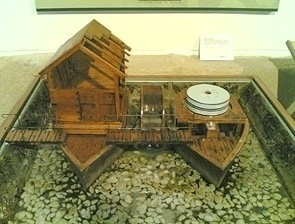 The museum traces the history of milling, showing the processes of grinding by hand, animal and human powered mills and the development of the mill throughout history, with interesting graphics and visuals which trace the technological advances that enabled a growing population to process greater quantities of flour.
The museum traces the history of milling, showing the processes of grinding by hand, animal and human powered mills and the development of the mill throughout history, with interesting graphics and visuals which trace the technological advances that enabled a growing population to process greater quantities of flour.
One innovation we found particularly interesting was the arab method of mobile water mills on boats, which harnessed the power of the water without being destroyed by flood damage following heavy rains, and which could be pulled away from the banks in times of danger to prevent their destruction or capture.
This type of mill was believed to have been in use on the existing site during the Moorish occupation, prior to the 13th century.
 Murcia has a wide network of irrigation channels, wells, and watermills, constructed during the Moorish occupation, the Moorish tribes being masters of water management and control. The systems they installed, together with their methods of agricultural controls and the crops they introduced, changed the face of Murcia, making it the region that we see today, and by the 12th century their legacy was a fertile and well cultivated region.
Murcia has a wide network of irrigation channels, wells, and watermills, constructed during the Moorish occupation, the Moorish tribes being masters of water management and control. The systems they installed, together with their methods of agricultural controls and the crops they introduced, changed the face of Murcia, making it the region that we see today, and by the 12th century their legacy was a fertile and well cultivated region.
By the 13th century Murcia had a wide network of watermills, in use for both the grinding of flour and for the fulling of cloth, and the first documented evidence of a watermill on this site can be seen on a seal , granted to the city by the King Alfonso X, El Sabio, in 1266 which clearly shows a waterwheel.
In 1364 there are written records of the existence of a mill in this exact spot and by the 16th century more extensive records start to appear reference the financial operations of the mill.
 At this point in history the mills which were in this location were run by the important families in the area who owned the rights to operate them, paying taxes to the councils, although the mills and water were technically council property. Rents, however, were derisory, and these powerful families, whose names will appear time and time again in the history of the region, the Fajardos, Calvillos and Manuel families, became known as the "lords of the mill" making enormous profits from their operation.
At this point in history the mills which were in this location were run by the important families in the area who owned the rights to operate them, paying taxes to the councils, although the mills and water were technically council property. Rents, however, were derisory, and these powerful families, whose names will appear time and time again in the history of the region, the Fajardos, Calvillos and Manuel families, became known as the "lords of the mill" making enormous profits from their operation.
However,in 1743, there were devastating floods which destroyed the wooden mediaeval mills, and at this point the council seized the opportunity to regain control of the operations when the vast cost of rebuilding in stone forced the council to mortgage part of the municipal property to pay back the loans required.
The council rebuilt the mills and the bridge of Puente Mayor, the old stone bridge which is still there today, retaining 5 of the mills for itself, and ceding only one to the remaining nobility, the Counts of Valle de san Juan.
However, in 1784, disastrous floods destroyed the mill once again, and the new mill as it became known was constructed.
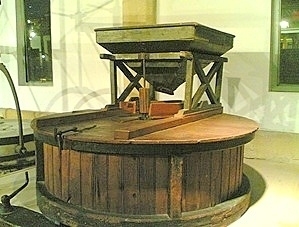 At this point it held 21 millstones, but by the early 19th century four more had been added, and this mill is often referred to as the "twenty four stones" mill.
At this point it held 21 millstones, but by the early 19th century four more had been added, and this mill is often referred to as the "twenty four stones" mill.
The council managed to keep hold of the mill ownership, but in the early 19th century ran up horrific debts and was eventually forced to sell the mills off to private ownership. By this process, a miller was able to buy and operate just a part of the whole mill operation, so several millers worked from the same location.
However, advances in technology meant that the mills were unable to compete with mechanised mills, and by the 20th century the old watermills were in decline, milling pepper and coarse meal to survive.
There is a little exhibit in the museum, a can of pimiento, the red powdered cooking ingredient used so widely by Murcians in their meals and which is produced from the small peppers which grow so well in the heat of the Region, a testament to the last miller who worked in the building milling pepper, before the building finally fell into dis-use.
 Those with mechanical minds will find the mill fascinating, as the staff regularly start up the machinery and show the process of how the mill worked. One thing we personally found very interesting was the attention given to controlling the speed of the millstones; the friction created could easily cause sparking if the stones were run too fast or without grain running through them, so a bell alerted the miller to the moment at which the last grain had run out of the hopper and onto the stones.
Those with mechanical minds will find the mill fascinating, as the staff regularly start up the machinery and show the process of how the mill worked. One thing we personally found very interesting was the attention given to controlling the speed of the millstones; the friction created could easily cause sparking if the stones were run too fast or without grain running through them, so a bell alerted the miller to the moment at which the last grain had run out of the hopper and onto the stones.
Children and big kids alike will enjoy the working models which show how the various types of mill operated, with systems put in place to regulate the flow of water, and will love pressing the buttons to operate the models and see what they do, whilst those more culturally minded will just appreciate the structure of the building and the contents of the galleries at the time of visiting.
Monumento a la sardina
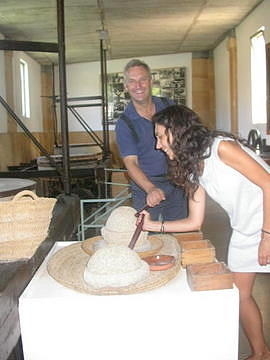 One little thing that makes a visit to this museum particularly enjoyable is the presence of a giant sculpture in the river outside, the imposing La Sardina del Rio Segura, a homage to the grand fiesta of the "Entierro de la sardine" which takes place in the spring every year.
One little thing that makes a visit to this museum particularly enjoyable is the presence of a giant sculpture in the river outside, the imposing La Sardina del Rio Segura, a homage to the grand fiesta of the "Entierro de la sardine" which takes place in the spring every year.
Although the title of the fiestas implies the burying of the sardine, it´s actually burned at the end of the fiestas, and isn´t a real sardine, but an enormous paper and wood sardine. It´s a wonderful fiesta, click Entierro de la sardina to see a report written after attending the fiesta. It´s a crazy fiesta and great fun to visit, held immediately after Easter every spring.
This magnificent sculpture is 23 metres long, weighs 12 tons and was created by Miguel Llamas. The fish is capable of spraying water for a further 23 metres and has a lighting system which simulates its burning at night-time.
Practicalities of visiting the Murcia watermill museum
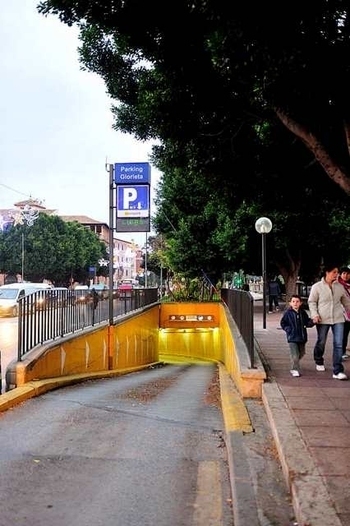 Location
Location
Calle de los Molinos, Murcia.
Click Los Molinos del Rio Segura for map
This is facing the Town Hall on the opposite side of the river, so crossing over the Puente Mayor Bridge, it can be seen to the left. The easiest parking is in the Glorieta underground carpark.
Simply drive off the Autovia following the signs for Centro Ciudad. On the right hand side are gardens and the river. Once past the bridge, make sure to stay in the right hand lane and the underground car park is directly on the right hand side.
It´s a 2 minute walk to the museum from the car park across the bridge.
Access
Steps and a ramp lead down to the museum and internally there are ramps to facilitate limited mobility access.
Opening Times:
Winter , 1st September- 30th June
Monday- Saturday 10-2 and 5-8
Sundays and fiesta days, closed
Summer, 1st July-31st August
Monday to Friday 10-2 and 5-8
Saturday, Sunday and festival days, closed
Entrance is completely free.
Would we recommend it?
Absolutely, its an excellent museum, a good place to take the kids and a good place for the technically minded who aren't interested in archaeology or art.
Cartagena
El Carmoli
Islas Menores and Mar de Cristal
La Manga Club
La Manga del Mar Menor
La Puebla
La Torre Golf Resort
La Union
Los Alcazares
Los Belones
Los Nietos
Los Urrutias
Mar Menor Golf Resort
Pilar de la Horadada
Playa Honda / Playa Paraiso
Portman
Roldan and Lo Ferro
San Javier
San Pedro del Pinatar
Santa Rosalia Lake and Life resort
Terrazas de la Torre Golf Resort
Torre Pacheco
Aledo
Alhama de Murcia
Bolnuevo
Camposol
Condado de Alhama
Fuente Alamo
Hacienda del Alamo Golf Resort
Lorca
Mazarron
Puerto de Mazarron
Puerto Lumbreras
Sierra Espuna
Totana
Abaran
Alcantarilla
Archena
Blanca
Corvera
El Valle Golf Resort
Hacienda Riquelme Golf Resort
Lorqui
Molina de Segura
Mosa Trajectum
Murcia City
Peraleja Golf Resort
Ricote
Sucina
Condado de Alhama
El Valle Golf Resort
Hacienda del Alamo Golf Resort
Hacienda Riquelme Golf Resort
Islas Menores and Mar de Cristal
La Manga Club
La Torre Golf Resort
Mar Menor Golf Resort
Mazarron Country Club
Mosa Trajectum
Peraleja Golf Resort
Santa Rosalia Lake and Life resort
Terrazas de la Torre Golf Resort
La Zenia
Lomas de Cabo Roig

CAMPOSOL TODAY Whats OnCartagena SpainCoronavirusCorvera Airport MurciaMurcia Gota Fria 2019Murcia property news generic threadWeekly Bulletin















